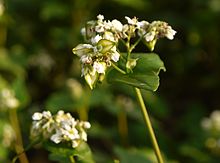| Buckwheat | |
|---|---|

| |
| Scientific classification | |
| Kingdom: | Plantae |
| Clade: | Tracheophytes |
| Clade: | Angiosperms |
| Clade: | Eudicots |
| Order: | Caryophyllales |
| Family: | Polygonaceae |
| Genus: | Fagopyrum |
| Species: | F. esculentum
|
| Binomial name | |
| Fagopyrum esculentum | |
| Synonyms[1] | |
| |
Buckwheat (Fagopyrum esculentum) or common buckwheat[2][3] is a flowering plant in the knotweed family Polygonaceae cultivated for its grain-like seeds and as a cover crop. Buckwheat originated around the 6th millennium BCE in the region of what is now Yunnan Province in southwestern China. The name "buckwheat" is used for several other species, such as Fagopyrum tataricum, a domesticated food plant raised in Asia.
Despite its name, buckwheat is not closely related to wheat. Buckwheat is not a cereal, nor is it even a member of the grass family. It is related to sorrel, knotweed, and rhubarb. Buckwheat is considered a pseudocereal, because its seeds' high starch content allows them to be used in cooking like a cereal.
- ^ "The Plant List: A Working List of All Plant Species". theplantlist.org. Archived from the original on 22 December 2019. Retrieved 3 October 2014.
- ^ Wang, Ya; Nie, Zihan; Ma, Tingjun (2022-02-24). "The Effects of Plasma-Activated Water Treatment on the Growth of Tartary Buckwheat Sprouts". Frontiers in Nutrition. 9: 849615. doi:10.3389/fnut.2022.849615. ISSN 2296-861X. PMC 8908094. PMID 35284468.
- ^ "USDA GRIN Taxonomy". Retrieved 16 December 2014.